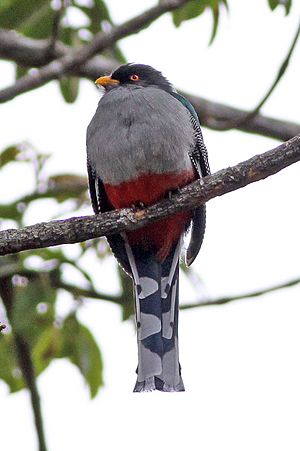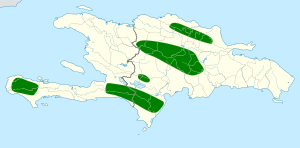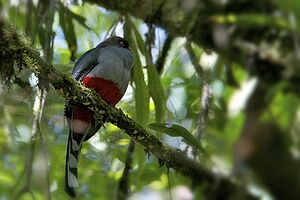Hispaniolan trogon facts for kids
Quick facts for kids Hispaniolan trogon |
|
|---|---|
 |
|
| In Sierra de Bahoruco National Park, Dominican Republic | |
| Conservation status | |
| Scientific classification | |
| Genus: |
Priotelus
|
| Species: |
roseigaster
|
 |
|
| Range in green | |
| Synonyms | |
|
Temnotrogon roseigaster |
|
The Hispaniolan trogon (Priotelus roseigaster) is a beautiful bird that lives on the island of Hispaniola. This island is home to both Haiti and the Dominican Republic in the Caribbean Sea. It is one of only two types of trogon birds found in the Caribbean. The Hispaniolan trogon is very special because it is the national bird of Haiti.
Contents
What Does the Hispaniolan Trogon Look Like?
Trogons are known for their bright colors and long tails. They have small feet and short, thick beaks. The Hispaniolan trogon has shiny green feathers on its back. Its throat and chest are gray, and its belly is a bright red.
You can tell it apart from the Cuban trogon by its tail. The underside of its tail is dark. But each tail feather has a wide white tip. Male and female trogons look quite similar. However, females have fewer white bars on their wing feathers.
What Sounds Do They Make?
The Hispaniolan trogon's song is slow and can be heard from far away. It also makes a low rattling sound.
Where Does the Hispaniolan Trogon Live?
These birds live in moist montane forests, which are forests found in mountains. They also live in forests that have been changed by human activity. Sadly, their homes are shrinking because of habitat loss. This means they are mostly found in a few protected areas now.
They live in different kinds of forests, including rain forests, dry forests, and pine forests. They need large, old trees with holes to build their nests. They usually live at high altitudes, from about 500 to 3,000 meters (1,600 to 9,800 feet). But sometimes they move to lower areas in the winter.
In Haiti, they are mostly found in two mountain ranges: the Massif de la Hotte and the Chaîne de la Selle. This is because much of their forest home has been lost. In the Dominican Republic, they are still quite common. Especially in the Sierra de Baoruco where the forests are less disturbed. However, their numbers are going down there too because of trees being cut down.
What Do Hispaniolan Trogons Eat?
Hispaniolan trogons mainly eat insects. But they also eat small animals like anole lizards. They enjoy fruits too, especially those from the West Indian sumac plant.
How Do They Find Food?
These birds likely find their food in a similar way to other trogons. They fly out from a perch to grab fruit or insects from nearby plants. They mostly look for food in the middle parts of humid forests. Sometimes, they join groups of different bird species when they are looking for food.
Life Cycle of the Hispaniolan Trogon
The Hispaniolan trogon's breeding season is thought to be from March to July. They build their nests inside holes in trees. Sometimes they even use old nest holes made by the Hispaniolan woodpecker.
They usually lay two eggs. The eggs are pale green and have no marks on them. The size of the eggs is about 2.8 to 3.1 centimeters long and 2.4 centimeters wide. We don't know exactly how long it takes for the eggs to hatch or for the baby birds to leave the nest. A generation of these birds is estimated to be about 7.3 years long.
Why Are They Protected?
The Hispaniolan trogon needs forests to survive. So, they are at risk when their forest homes are lost or damaged. The IUCN Red List says the Hispaniolan trogon is of "Least Concern" for now. This means they are not in immediate danger of disappearing.
However, their numbers are still going down across their small home range. This is because forests are being damaged and broken into smaller pieces. Cutting down trees for farming, making charcoal, and logging are big problems. This is especially true in moist forest areas. Pine forests are also shrinking due to logging.
In some areas, like the Cordillera Central, their numbers have dropped a lot. This is due to recent habitat destruction along highways. But sometimes, you can still see them on old coffee or cocoa farms. People also hunt these birds. Even though their home range is wide, it is becoming broken up.
Some populations of Hispaniolan trogons are protected in national parks, like the Sierra de Baoruco. To help these birds, people are trying to:
- Watch their population regularly.
- Protect the national parks where they live.
- Encourage farming methods that don't require cutting down forests.
- Stop people from making charcoal in native forests.
- Teach people about how unique these birds are and why hunting them is bad.
See also
 In Spanish: Trogón de La Española para niños
In Spanish: Trogón de La Española para niños



